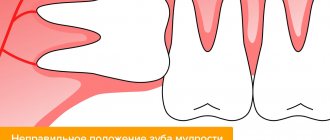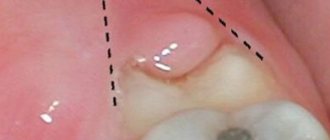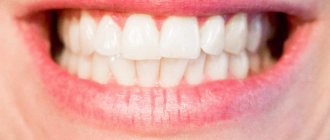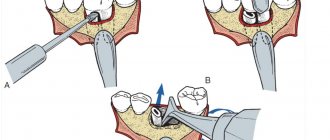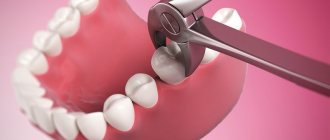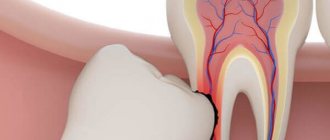Tooth extraction in dentistry is divided into simple and complex. When extracting a tooth with one root, such manipulation is considered simple. If the tooth has a complex root with several branches, then the procedure for removing it will be complex and is carried out using special tools and techniques.
In what cases is dental surgery difficult?
Complex manipulations regarding tooth extraction include the following situations:
- with disconnected roots that are excessively curved inward or directed in different directions;
- when the problem tooth is located in the affected bone;
- in the complete absence of a crown, when there is nothing to grab onto with forceps;
- if a filling was previously installed in the tooth, which can crack under the mechanical influence of forceps;
- when the tooth is impacted or dystopic;
- removing the "eight"
These are the main clinical features in which it is impossible to get rid of a diseased tooth using a standard simple procedure. Moreover, in each specific case the reasons for complex extraction may be individual.
Cases when complex surgery is necessary
It often happens that the only possible way to get rid of a defect formed by a complex tooth is to remove it.
Indications for this type of procedure are as follows:
- the formation of periodontal tumors and edema, accompanied by soreness of the mucous membranes and gums;
- numbness of the face resulting from damage to the nerve endings of a diseased tooth;
- with an increased risk of curvature of adjacent teeth;
- in the presence of diseases caused by improper positioning of the tooth.
Surgeries to remove problematic teeth are contraindicated for those who suffer from pathologies of the cardiovascular system, with poor blood clotting, patients who have undergone a hypertensive crisis, in the presence of infectious or viral processes in the body, as well as other individual contraindications.
We delete and do not resist
Despite the rapid development of methods in dentistry, there are still situations when it is necessary to agree to tooth extraction. Moreover, most often the procedure must be carried out urgently in order to prevent the spread of infection and relieve pain. Unconditional indications for tooth extraction are:
- An acute form of osteomyelitis caused by a diseased tooth. This is a severe bone lesion that even affects the bone marrow. This state of affairs is dangerous for your health. The disease is accompanied by acute, unbearable pain and body temperature up to 40 degrees.
- Advanced periodontitis. The rotting of the root membrane is very difficult to stop if you try to save the tooth. In this case, the situation is dangerous because the rotting zone can increase and affect neighboring areas of the jaw.
A tooth can also be removed if it is the cause of other diseases: neuritis, phlegmon, lymphadenitis, sinusitis, etc. In addition, there are non-infectious indications for removal . The doctor may suggest removing a tooth if:
- It grows out of line and interferes with the formation of a correct bite. Sometimes timely tooth extraction allows a child to return a beautiful smile without any braces. Sometimes it is necessary to combine these types of treatment.
- It is located at the site of fusion of a broken jaw. If the jaw is injured, surgical intervention is required for its proper fusion. A tooth located at the fracture site may interfere with the process. Once the jaw has been restored, a new tooth can be grown in place of the hole if you deem it necessary for functional or aesthetic reasons.
Preparing for dental surgery
If a patient is faced with the removal of a complex tooth, then an experienced doctor will not perform such manipulations without prior preparation. An x-ray is required before the operation. This is necessary to clarify the location of the tooth in the bone, as well as to evaluate the tissues surrounding it.
When a patient has an inflammatory process, it is first cured by taking antibiotics.
Complications after pulling out problem teeth rarely occur, but to avoid them, the procedure should be trusted to a highly qualified doctor.
How to remove complex teeth: basic techniques
In dentistry, various methods are used to eliminate a complicated tooth, the essence of which depends on the instruments chosen for manipulation:
- removal using forceps. Compared to
in other ways, this is considered the most gentle. This technique is used in cases where the integrity of the crown is preserved. The surgeon grabs the crown with forceps and loosens it in a circular motion until the tooth root ruptures from the alveolus, after which he pulls it out; - elevator extraction. If it is located outside the dentition, it is impossible to pull it out with ordinary forceps, then this technique is used. The instrument is inserted into the periodontal fissure and rotated, as a result of which the ligaments are torn. The tooth is not pulled out of the hole, but squeezed out;
- removal with a drill. This method is used to pull out teeth with multiple roots. First, the roots are separated using a drill and then each piece is removed separately. If a resorcinol-formalin filling is installed on a tooth, then a drill is also used to pull it out.
Which method is the best? Each has certain characteristics and is selected based on the condition of the tooth, the number and depth of its roots.
Dystropic tooth: indications for removal
A tooth with an incorrect location in the dentition relative to its neighbors is called dystrophic. It can take the place of another, spontaneously turn, change the angle of growth, which significantly interferes with neighboring teeth and leads to the formation of a malocclusion.
Indications for extraction of a dystrophic tooth are:
- swelling of the gums and pain;
- numbness of the face due to damage to nerve endings;
- pronounced curvature of adjacent teeth;
- periodontitis or chronic pulpitis;
- when, due to a problem tooth, it is impossible to perform prosthetics;
- if a dystrophic tooth is the cause of periostitis or osteomelitis.
The removal process itself is similar to the procedure for removing an impacted tooth.
Is it painful to remove a nerve from a tooth?
Modern dentistry has the widest possibilities and powerful universal anesthesia. Thanks to this, removal of the flock nerve is a painless procedure that is carried out during the visit. The only discomfort that the patient may feel concerns the injection into the gum. This can also be easily avoided by applying anesthesia, after which inserting a needle will not cause any discomfort.
Pain may occur in rare cases for one of the following reasons:
- Individual characteristics of the path of nerves, which is why standard techniques provide insufficient pain relief.
- Taking painkillers the day before by the patient, in particular from the group of non-steroidal anti-inflammatory drugs (NSAIDs), may reduce the effectiveness of anesthesia.
- The patient took alcohol before visiting the doctor.
- The patient belongs to the 2% of all people with immunity to anesthetics.
The solution to the problem in each case is the same - repeated anesthesia.
Extraction for acute and chronic inflammation
Quite often, the removal of a problematic tooth is accompanied by the presence of purulent foci, gum inflammation or periodontitis. In such cases, the doctor prescribes intensive therapy with the use of antibacterial drugs, and only after the inflammatory process has been suppressed is surgery to remove the tooth performed.
There are also situations when a tooth needs to be removed urgently. Only an experienced, highly qualified doctor can perform surgery in such cases.
Wisdom teeth: what is the difficulty of removing them?
If we are talking about the extraction of a wisdom tooth, then the complexity of the manipulation is explained by its very location in the dentition. Wisdom teeth are considered problematic because they:
- erupt much later than others;
- often grow with a bias to the side, thereby disturbing the evenness of the dentition;
- They react differently to surgical intervention: pronounced swelling of the gums appears, body temperature rises, and pain is much more intense.
Typically, such complications go away within a few days, provided proper care of the socket and oral cavity is performed.
Wisdom tooth – “secret agent”
Few people know in detail what kind of tooth this is and what its “wisdom” is.
And everything is quite simple - he is called that because he/they appear much later than the others, at the age when a person’s mental development is considered complete, and the acquisition of wisdom begins. It does not have a “milk” predecessor, and it grows only after the final formation of adult bone tissue. In our time, it has been proven: the wisdom tooth, also known as the eighth tooth, is a rudiment, a relic of evolution. Unlike ancient humans, our jaw is shorter, and there is simply no room for it. That's why Western dentists insist: it must be removed as soon as it begins to appear. However, in any case, if the “eight” causes pain, your best assistant is the dentist! After looking at the x-ray, he will tell you what to do next. If everything is fine with the newly erupted tooth, the dentist will prescribe a course of treatment that will relieve inflammation.
what to do with the eighth teeth based on the patient’s complaints and clinical picture. Problems with even one or two elements disrupt the normal functioning of the entire dental system. Pain appears when opening the mouth and chewing, sometimes the bite and position of the incisors change.
So, if the eighth tooth is problematic, then the surgeon will perform an operation to remove it.
Wisdom teeth that have not erupted or are in the wrong position make removal more difficult and require the use of a complex extraction method.
We remove the nerve, save the tooth
Removal of the nerve - depulpation - is necessary when:
- As a result of injury, the tooth enamel is chipped so badly that the nerve is affected.
- pulpitis was detected. Inflammation of the nerve can begin as a result of advanced caries.
- you are preparing for prosthetics and installation of orthopedic structures.
Removing a nerve today no longer requires the use of arsenic, and modern anesthesia literally works miracles. Not only the capital, but also Samara can boast of modern clinics where you can get rid of the nerve without hassle and pain. How much does it cost? The prices are quite reasonable!
Yes, after removing the nerve, the tooth will lose sensitivity and blood supply. But when the nerve disappears, the painful reaction to all irritants, including sweets, cold and hot, will also go away.
In any case, the dentist advises removing the nerve only when it is no longer possible.
Complex tooth extraction: when is it necessary?
Clinical indications for which the dentist prescribes complex tooth extraction are as follows:
- the presence of an unerupted wisdom tooth in the jaw;
- if the figure eight is incorrectly positioned;
- when removing molars with two or three roots;
- with a severely damaged or twisted root;
- in case of fusion of the tooth root with the jaw bone tissue;
- in the presence of a fistula or cyst;
- with excessive fragility of the crown due to treatment with resorcinol-formalin composition.
The operation itself consists of several stages and is carried out under the influence of powerful anesthetics.
Stages of complex tooth extraction
Complex removal surgery is carried out only after x-ray diagnostics, during which the shape, length and depth of the roots are determined. If the patient has inflammation, he is prescribed treatment with antibacterial drugs.
Technique of the procedure
Wisdom tooth removal is carried out in the following order:
- the gum is separated from the neck of the tooth by making an incision in the soft tissue;
- if necessary, the interroot septum is sawed or sections of bone tissue are cut out at the location of the tooth;
- then, using forceps, the tooth is rocked and pulled out of the socket;
- Sutures are placed on the gum.
Painkillers are not required after the procedure, since the effect of the anesthetics is still present.
The site of tooth extraction hurts after a week, what should I do?
The holes in which the extracted teeth were located are usually completely healed by the end of the first week. Final healing still needs to wait, but the pain should have passed during this period. If, after a week, the area continues to hurt after tooth extraction or any other symptoms appear, such as bleeding, the patient urgently needs to see a doctor.
Under no circumstances should you try to relieve pain on your own. If it continues to bother the patient, this may indicate the development of inflammation or an abscess process in the gum. If they are not eliminated in time, the consequences can be very serious.
The healing process of the hole after a complex removal
Basically, tissue healing occurs after 7-10 days. It should be noted that this period is quite difficult for the patient. As soon as the effect of the anesthetics stops, aching pain immediately occurs. To eliminate it, you should take pain medication.
The swelling and redness that appears will decrease every day. If there is slight itching in the socket area, this indicates intensive tissue restoration. Removal of sutures after healing is not required since they “dissolve” on their own.
During the regeneration period after removal, it is very important not to disrupt the integrity of the blood clot formed in the socket. To do this, you need to follow a few simple rules:
- during the first 2-3 hours after surgery, do not consume any drinks, much less food;
- Under no circumstances should the well be heated, cleaned or washed;
- do not rinse your mouth for 24 hours after removal;
- When eating food, you need to chew it on the opposite side in relation to the hole.
If you follow these recommendations, the tissue will soon recover without complications.
Why does a pulled out tooth hurt?
The presence of pain after tooth extraction is due to the fact that soft tissues, blood vessels and nerves are damaged during tooth extraction. Typically, the first pain symptoms appear 3-4 hours after surgery. This is due to the fact that this is when the anesthesia stops working.
Also, during removal, the bone tissue of the jaw socket may be damaged. In this case, the pain during the healing period is more intense and prolonged. However, if the removal was carried out correctly, it will soon pass.
How long does it hurt?
In most cases, pain during removal worsens on the second day. On the third day they begin to decrease. By the fourth or fifth day, there is practically no pain. If by this period the pain after tooth extraction does not subside, the patient should consult a doctor, as this may indicate the emergence of complications.
However, it is important to remember that complete healing of the hole occurs only in the second or third week after the procedure. Until this time, the gums and bone tissue are vulnerable, so if they are irritated, pain may also occur. To prevent this from happening, you should follow your doctor's recommendations.
Headache
The recovery period after tooth extraction may be accompanied by headaches of varying intensity. They are associated with damage to the nerve fibers that go to the brain. Such symptoms should not frighten the patient, since as the wound heals, they will also pass.
Another cause of headaches during this period may be hypertension. The patient must notify the attending physician about the presence of such an illness. In this case, the surgeon will be able to select appropriate medications that will reduce pain.
Ear pain
For the same reasons, a patient may experience unpleasant or even painful sensations in the ear after tooth extraction. Most often they have a shooting character. This symptom is also normal and goes away in the coming days after the intervention.
Ear pain may worsen if, after the procedure, the patient does not properly care for the oral cavity and tries to chew solid food.
Pain in the gums
Pain in the gum is associated with its direct damage. In this case, not only the soft tissue suffers, but also the nerves, which are also located in the gums. Depending on the degree of damage, pain can last for different times and occur with greater or less intensity.
Increased pain in the gum may indicate the presence of fragments in its tissues, as well as the occurrence of one or another complication. If such symptoms occur, you should immediately consult a specialist.


